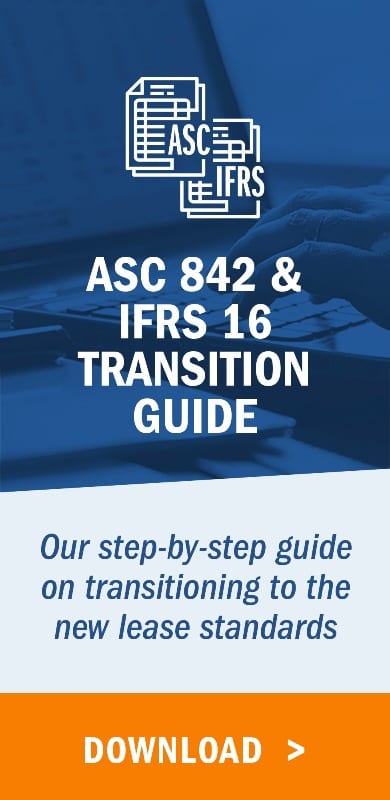Prior to the introduction of the new lease accounting standard, ASC 842, many organizations grouped their leased assets along with their fixed assets. The organization likely placed assets financed with a capital lease on the balance sheet as “capital assets” and accounted for them within their existing fixed asset accounting application.
While this was an adequate accounting treatment under ASC 840, the previous lease accounting standard, the complex new guidelines demand a dedicated accounting solution to support the updated accounting and reporting requirements.
ASC 840 vs. ASC 842
Under ASC 842, accounting for leased assets is still based on lease classification, but the resulting accounting treatment has been updated in some cases. The right to use equipment or property rented through an operating lease agreement is assigned a value, recorded on the balance sheet as an asset and depreciated over the shorter of the term of the contract or the useful life of the asset.
This is in contrast to the accounting treatment of assets rented with an operating lease under ASC 840. The legacy lease accounting standards did not require the assets underlying an operating lease to be recorded on the balance sheet.
Both ASC 840 and ASC 842 require the capitalization of the asset(s) underlying a capital or finance lease, respectively. These assets are placed on the balance sheet as capitalized or finance lease assets and depreciated. Under ASC 842 finance leases transferring ownership of the underlying asset(s) at the end of the lease term or those with a bargain purchase option, depreciate the underlying asset(s) over their useful life, as if the asset(s) were owned. Finance leases without a purchase option or ownership transfer depreciate the underlying asset(s) over the shorter of the useful life or the lease term.
Lease liability
The most significant reason for using a lease accounting module in addition to your existing fixed asset application is the need for lease accounting and financial reporting. While you may be able to add your capitalized right-of-use assets as fixed assets in a fixed asset module, this would not capture the lease liability.
To account for a lease liability, you need the lease amortization table which provides the periodic liability balance reduction and interest expense. If the entity has only a few capital/finance leases, creating the amortization tables manually in Excel might not be time-consuming. However, with the requirement for operating leases to have a lease liability under ASC 842, now entities will need amortization tables for their entire lease portfolio.
One of the main functions of a lease accounting module is to create an amortization table for each lease based on the lease data provided. A lease accounting application removes the need to manually create the lease amortization tables, reducing the time and effort required for compliance.
Expenses
A fixed asset module tracks individual assets and provides the necessary depreciation expense. If you were to use a fixed asset module for your operating lease and finance lease ROU assets, the fixed asset module could track the assets and provide the finance lease asset amortization expense.
However, the fixed asset module would not provide the interest expense and liability reduction for finance leases and the single lease expense for operating leases. These expenses would have to be calculated in a separate modulate or spreadsheet in addition to the leased assets entered into the fixed asset module.
Using a lease module in addition to your fixed asset module allows you to track your lease liability and related right of use assets in one place. It also allows you to go to one application for all of your lease-related expenses, providing more efficiency than using a fixed asset application in addition to another solution for the liability side.
Asset amortization
Under ASC 842, an operating lease right-of-use asset is reduced periodically by the difference between the straight-line lease expense and the calculated accrued interest expense on the lease liability. The operating lease right-of-use asset amortization is not a constant amount, nor is it any of the existing asset depreciation methods.
If you were to include any operating lease right-of-use assets in a fixed asset module, you would be unable to assign a method for calculating depreciation expense. Instead, depreciation would need to be manually provided each period for each asset.
A lease accounting application would automatically calculate the appropriate ROU asset amortization for both operating lease and finance lease assets. Manual calculations for amortization expense would not be necessary, mitigating the possibility of errors and financial statement misstatement.
Financial reporting
With the new lease accounting requirements comes updated cash statement classification, quantitative disclosures, and qualitative disclosures, in addition to the new balance sheet and income statement reporting. A lease accounting application can provide the consolidated schedules for the quantitative disclosures directly from the source and save the added step of compiling information from the fixed asset module plus schedules from the application where your lease liability information is.
Summary
Using modules that integrate into your ERP should provide accuracy for accounting and reporting. Accuracy results from automatic calculations and the direct transfer of data to your general ledger. The possibility of a variety of manual errors is significantly reduced.
Attempting to complete your lease accounting with a fixed asset module only provides accuracy for the leased assets, negating the benefits of using a module because a separate manual process will be needed for the lease liabilities.
Ensure your lease accounting is accurate and efficient by using a lease accounting module in addition to your existing fixed asset module.


